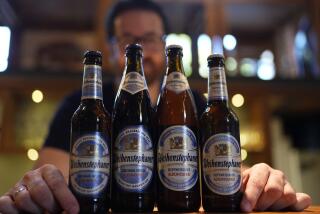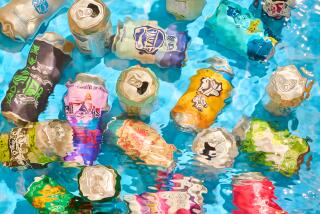Latest Brew-haha : Beverage Giants Banking on âIceâ Beer to Rally Sales
When John Frank goes bowling Monday nights, he pays almost as much attention to which beers his buddies order as he does to the score sheet. Thatâs why Frank, who is editor of Beverage Industry magazine, was all ears recently when a nearby bowler ordered an âiceâ beer--a newfangled beer brewed at super-cold temperatures.
âIt tastes a lot colder than regular beer,â Frank recalls the thirsty but misguided bowler saying after his first gulp. âThat must be why they call it ice beer.â
Those words, off-base as they are, make sweet marketing music to the ears of the beer giants. Facing years of declining sales, brewers are desperate to persuade consumers that they have created a beer that is better than yesterdayâs brew.
Ice beer is not a frosty mug of beer with ice cubes clinking inside. It is simply beer brewed at a temperature so cold that ice crystals form. The process was devised in Germany but popularized in Canada, and beer makers insist it makes the brew taste richer. Ice beer--which often has a higher alcohol content than regular beer--is already being marketed as the hottest thing since, well, dry beer.
This week, Miller Brewing plans a national rollout of its light ice beer, and Coors begins a limited distribution of its own icy brew.
Industry skeptics say the brewing brouhaha is little more than a marketing gimmick aimed at prodding beer drinkers to pay up to 50 cents more for a six-pack.
Because of incessant ad campaigns from Madison Avenue image makers, ânobody wants to drink their fatherâs beer,â said Frank, who marvels at repeated attempts by big brewers to market something new. âI call this the slippery ice beer segment.â
But the major brewers call it something else: hope.
In Canada, where it has been marketed for slightly more than a year, ice beer already accounts for nearly 12% of the market. By the end of 1994, industry consultants say ice beer could account for 2% of the much bigger U.S. market--worth almost $1 billion in retail sales. By comparison, dry beer sales accounted for about 1.7% of the domestic beer market in 1993.
âEvery brewer with a marketing department worth its salt is saying: âHey, Iâve got to get in on this,â â said Jerry Steinman, publisher of Beer Marketerâs Insights, a West Nyack, N.Y.-based industry newsletter.
Thatâs why each brewer is already claiming some sort of ice beer âfirst.â Labattâs says it was first to sell it in North America. Coors claims it is first to use the technology domestically. Anheuser-Busch has first dibs on the draft version. And Miller boasts it is brewing the first low-calorie ice beer. Can a clear ice beer be far off?
*
Few have forgotten the huge lead that Miller Brewing took in the light beer segment in 1973, when it introduced light beer and everyone else watched it steal the market.
âItâs a hot time for ice beer,â said Lynn Dornblaser, publisher of the trade magazine New Product News. One year ago, the domestic ice beer segment didnât even exist. Today, however, a dozen or so ice beer products have already been announced.
âIt will probably be one of the hottest new products of 1994,â Dornblaser said. âBut look for it to fade by 1995.â
Yet the industry push for ice beer is almost frantic. Thatâs because the beer industry is reeling from five consecutive years of flat sales. The problem is particularly acute in California, where per-capita consumption dropped 12% last year, according to one consultant.
The big brewers have spent millions of dollars over the past decade trying to persuade consumers to buy new beer products that are âdry,â âdraft,â âclear,â âlight,â âlow-alcohol,â âno-alcohol,â âlow calorieâ and the most recent entry--âice.â
Several brewers have also just begun promoting âredâ beers--which are slightly heavier brews that typically have a reddish tint to them.
Until the mid-1970s, brewers mostly sat back and watched sales grow. But health concerns led to modified drinking, and some beer drinkers now prefer specialty beers from brew pubs and microbreweries. This has forced the brewers to battle fiercely for market share.
âFor the first time in its history, the brewing industry has to come up with new ways to develop the beer market,â said Bob Weinberg, a St. Louis brewing industry consultant.
*
But not everyone approves of the ice beers, most of which have an alcohol content of 5.5% by volume, compared to 5% for many regular beers.
âIn a society with 13 million alcoholics, we donât need this kind of product,â said Thomas R. Neslund, executive director of the Silver Springs, Md.-based International Commission for the Prevention of Alcoholism and Drug Dependency. âIt will appeal to younger drinkers in particular--who are the least well-informed.â
But Anheuser-Busch executives point out that their ice beer has the same alcohol content as their regular beer.
âIn todayâs environment, we certainly donât want to get into an alcohol content war,â said August A. Busch IV, vice president of brand management.
Miller Brewing Co. executives say the higher alcohol content in their ice beer is only the incidental result of the brewing process.
âWe are not trying to sell higher-octane beer,â said Richard P. Lalley, director of new business development for Miller, which makes Miller Icehouse beer, and which this week will roll out Miller Lite Ice. âWe have a product with a taste that consumers say they want.â
But the additional alcohol has also led to some marketing glitches. State laws in California and Texas are forcing most of the brewers to refer to the higher alcohol brews as âaleâ instead of beer in regional advertising.
âSure, it results in some confusion,â Lalley said. Still, Millerâs ice beer sales could account for up to 4% of its market share by the end of the year, he said.
There is even a battle raging over the term ice. Labatt Breweries of Canada, first to sell ice beer in Canada, recently sued rival brewers Miller and Molson for using the term ice brewing in ads, saying it has exclusive rights to that phrase.
Coors Brewing Co., which signed a domestic licensing deal with Labatt, will this week begin distribution of Coors Artic (yes, thatâs how they misspell it) ice beer, said Jon Runge, new product development director. And industry giant Anheuser-Busch began selling Ice Draft beer in the West four months ago. By the end of 1994, ice beer could account for 4% of the companyâs sales.
But ice beer has a long way to go to make a believer out of Dan Snook, general manager of Strattonâs bar in Westwood. Although his tavern has plenty of ice beer on tap, few of the UCLA students and professors who frequent Strattonâs ask for it, he said.
âItâs just a gimmick,â Snook said. âIn fact, Iâm planning to phase it out.â
Briefly . . .
The Los Angeles agency Asatsu/BBDO has picked up the estimated $5-million ad business to help launch a new video component line for El Segundo-based Aura Systems. . . . The Los Angeles agency Stein Robaire Helm has picked up the $2-million ad account for the Santa Ana-based Orange County Register, which was formerly handled in-house. . . . Canoga Park-based Redken Laboratories has placed its $6-million account, which has been handled by Stein Robaire Helm, in review. . . . The Advertising Industry Emergency Fund is accepting requests for financial assistance from qualifying earthquake victims who are ad industry professionals. For information, call (213) 655-1951. . . .
More to Read
Inside the business of entertainment
The Wide Shot brings you news, analysis and insights on everything from streaming wars to production â and what it all means for the future.
You may occasionally receive promotional content from the Los Angeles Times.










